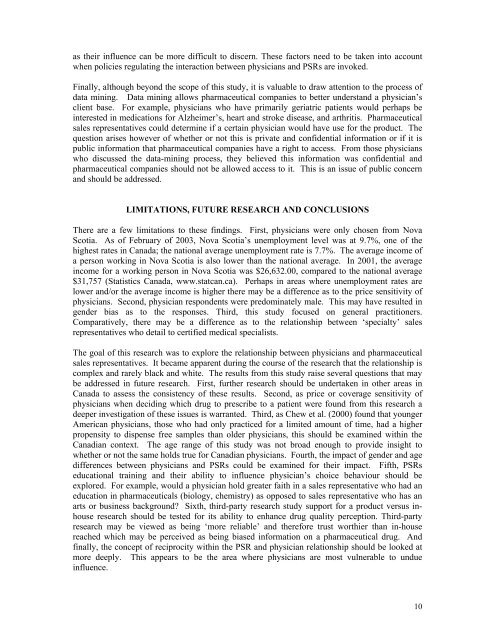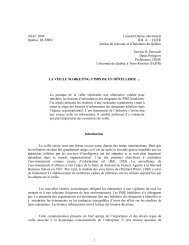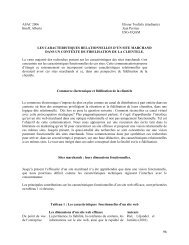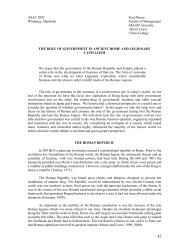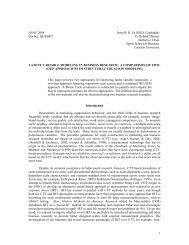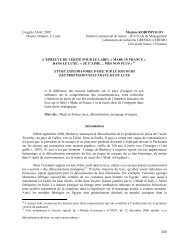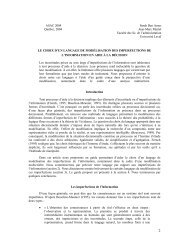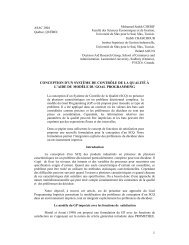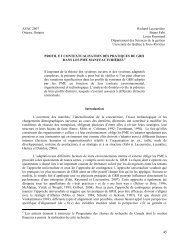ASAC 2004 – Quebec City Lynne Gillis – St. Francis Xavier ...
ASAC 2004 – Quebec City Lynne Gillis – St. Francis Xavier ...
ASAC 2004 – Quebec City Lynne Gillis – St. Francis Xavier ...
Create successful ePaper yourself
Turn your PDF publications into a flip-book with our unique Google optimized e-Paper software.
as their influence can be more difficult to discern. These factors need to be taken into account<br />
when policies regulating the interaction between physicians and PSRs are invoked.<br />
Finally, although beyond the scope of this study, it is valuable to draw attention to the process of<br />
data mining. Data mining allows pharmaceutical companies to better understand a physician’s<br />
client base. For example, physicians who have primarily geriatric patients would perhaps be<br />
interested in medications for Alzheimer’s, heart and stroke disease, and arthritis. Pharmaceutical<br />
sales representatives could determine if a certain physician would have use for the product. The<br />
question arises however of whether or not this is private and confidential information or if it is<br />
public information that pharmaceutical companies have a right to access. From those physicians<br />
who discussed the data-mining process, they believed this information was confidential and<br />
pharmaceutical companies should not be allowed access to it. This is an issue of public concern<br />
and should be addressed.<br />
LIMITATIONS, FUTURE RESEARCH AND CONCLUSIONS<br />
There are a few limitations to these findings. First, physicians were only chosen from Nova<br />
Scotia. As of February of 2003, Nova Scotia’s unemployment level was at 9.7%, one of the<br />
highest rates in Canada; the national average unemployment rate is 7.7%. The average income of<br />
a person working in Nova Scotia is also lower than the national average. In 2001, the average<br />
income for a working person in Nova Scotia was $26,632.00, compared to the national average<br />
$31,757 (<strong>St</strong>atistics Canada, www.statcan.ca). Perhaps in areas where unemployment rates are<br />
lower and/or the average income is higher there may be a difference as to the price sensitivity of<br />
physicians. Second, physician respondents were predominately male. This may have resulted in<br />
gender bias as to the responses. Third, this study focused on general practitioners.<br />
Comparatively, there may be a difference as to the relationship between ‘specialty’ sales<br />
representatives who detail to certified medical specialists.<br />
The goal of this research was to explore the relationship between physicians and pharmaceutical<br />
sales representatives. It became apparent during the course of the research that the relationship is<br />
complex and rarely black and white. The results from this study raise several questions that may<br />
be addressed in future research. First, further research should be undertaken in other areas in<br />
Canada to assess the consistency of these results. Second, as price or coverage sensitivity of<br />
physicians when deciding which drug to prescribe to a patient were found from this research a<br />
deeper investigation of these issues is warranted. Third, as Chew et al. (2000) found that younger<br />
American physicians, those who had only practiced for a limited amount of time, had a higher<br />
propensity to dispense free samples than older physicians, this should be examined within the<br />
Canadian context. The age range of this study was not broad enough to provide insight to<br />
whether or not the same holds true for Canadian physicians. Fourth, the impact of gender and age<br />
differences between physicians and PSRs could be examined for their impact. Fifth, PSRs<br />
educational training and their ability to influence physician’s choice behaviour should be<br />
explored. For example, would a physician hold greater faith in a sales representative who had an<br />
education in pharmaceuticals (biology, chemistry) as opposed to sales representative who has an<br />
arts or business background? Sixth, third-party research study support for a product versus inhouse<br />
research should be tested for its ability to enhance drug quality perception. Third-party<br />
research may be viewed as being ‘more reliable’ and therefore trust worthier than in-house<br />
reached which may be perceived as being biased information on a pharmaceutical drug. And<br />
finally, the concept of reciprocity within the PSR and physician relationship should be looked at<br />
more deeply. This appears to be the area where physicians are most vulnerable to undue<br />
influence.<br />
10


